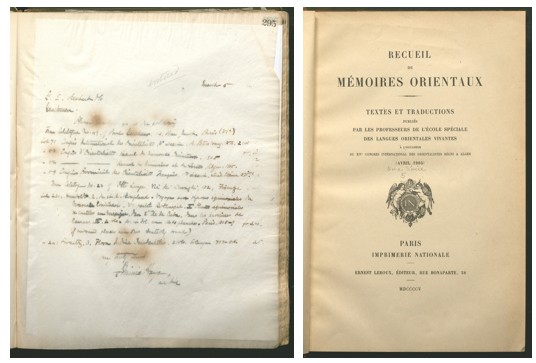Traces of the Titanic, or Lost and Found in the APS Archives
Above: Painting of the RMS Titanic sinking, courtesy of the Royal Museums Greenwich
The tragic tale of the RMS Titanic is well known and reflected in books, movies, and popular culture. Whatever the media, the accounts tend to focus on the human toll – justifiably so – and acts of courage in the face of a terrible disaster. Given this perspective, I hadn’t thought much about other losses associated with the Titanic, such as cargo, until I recently processed the I. Minis Hays Records. As I worked through Hays’ correspondence from 1912, I was intrigued to find that books destined for the APS were also lost in the devastating wreck.
The event occurred well into Hays’ life (1847-1925) and his involvement at the Society, to which he was elected in 1886. Hays had a successful career in medicine before serving as APS Librarian, and he brought a new level of professionalism to the department. Part of what distinguished his tenure was a more systematic approach toward collection development, which is reflected in extensive correspondence he had with booksellers from around the world.
One firm that Hays relied heavily upon was G.E. Stechert & Company, which carried new and used books, and had offices in New York, London, Leipzig, and Paris. In the first four months of 1912, prior to the sinking of the Titanic, Hays and Stechert exchanged approximately 40 letters, some written on the same day. Even with our current standards for email and text messaging, this indicates a close working relationship.

It was the letter from April 16th that caught my attention, in which a Stechert representative informed Hays that the Society’s shipment of British journals and second-hand books sank on the Titanic. This is corroborated by the ship’s manifest, or inventory of goods that went on board: boxes of books were listed as part of the cargo.
While the Titanic was designed primarily for passenger transport, the ocean liner could carry a fair amount of cargo in its lower decks. It was given the designation of a Royal Mail ship (RMS), and was under contract to transport mail for the United Kingdom and the United States Postal Service.

This immediately piqued my curiosity: which books were lost at sea, and was Stechert able to replace them, as was promised in the letter? Unfortunately, the answer was not so simple. The documentation I found in Hays’ records – primarily his incoming correspondence – was not sufficient to fully reconstruct what was being sent when.
Granted, Stechert’s staff would acknowledge the orders that Hays and his assistant, Ella Morison, placed with the firm, and indicate which shipments would be imported (if the books weren’t on hand in New York). I zeroed in on an acknowledgement from March that likely corresponded with the Titanic shipment; however, the books to be imported were not listed. Now, it was a matter of tracking down Hays’ book order, ideally located in his outgoing correspondence, but this was presumed to be missing from the Librarian’s records.
Thanks to a tip from Valerie-Anne Lutz, Head of Manuscript Processing and Assistant Librarian, I checked the letterpress copy books kept by the Secretary of the APS. In the days before typewriters and carbon copies, staff would press a freshly handwritten letter onto moistened tissue paper to make an impression of the ink. Based on the finding aid for this section of the APS Archives, I wasn’t optimistic; the Librarian’s outgoing correspondence wasn’t specified.
Fortunately, upon investigation, I was delighted to find that Hays’ letters were indeed there! It turns out that he wore two hats at the time, as both Secretary and Librarian. Thrifty and efficient as ever – this was someone who went out of his way to buy second-hand books – it’s not surprising that Hays kept only one volume for all of his outgoing correspondence. Why this wasn’t noted before is understandable, because the APS Archives is a large and complex collection, letterpress copy books are an imperfect medium, and Hays, for all his merits, had terrible handwriting.

One title that I was able to decipher in Hays’ book order was Recueil de mémoires orientaux. I found it listed in Koha, our online catalog, and on the shelf in Franklin Hall (see above for its title page). At least this volume eventually made it to the Library – perhaps others from Stechert were replaced, as well. While further research is needed, I hope this post provides a glimpse into how circuitous the process can be, even for those familiar with the material. Fortunately for us, Hays’ outgoing correspondence as Librarian is not lost, like the ill-fated ship that lies at the bottom of the sea. I’ve also updated the APS Archives finding aid, so other researchers can find buried treasure in Hays’ letterpress copy books.


